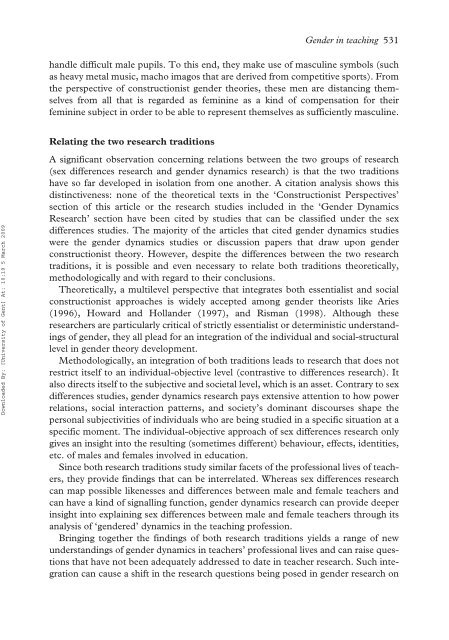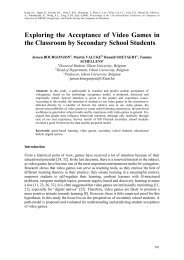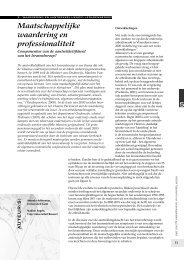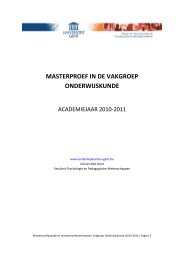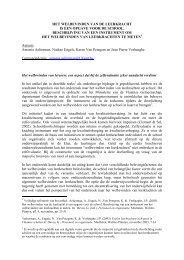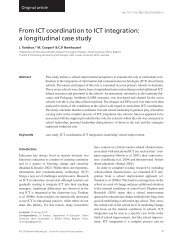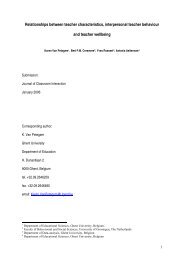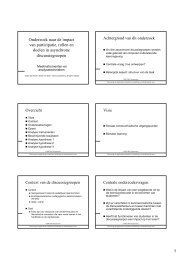PLEASE SCROLL DOWN FOR ARTICLE
PLEASE SCROLL DOWN FOR ARTICLE
PLEASE SCROLL DOWN FOR ARTICLE
You also want an ePaper? Increase the reach of your titles
YUMPU automatically turns print PDFs into web optimized ePapers that Google loves.
Gender in teaching 531<br />
handle difficult male pupils. To this end, they make use of masculine symbols (such<br />
as heavy metal music, macho imagos that are derived from competitive sports). From<br />
the perspective of constructionist gender theories, these men are distancing themselves<br />
from all that is regarded as feminine as a kind of compensation for their<br />
feminine subject in order to be able to represent themselves as sufficiently masculine.<br />
Relating the two research traditions<br />
Downloaded By: [University of Gent] At: 10:19 5 March 2009<br />
A significant observation concerning relations between the two groups of research<br />
(sex differences research and gender dynamics research) is that the two traditions<br />
have so far developed in isolation from one another. A citation analysis shows this<br />
distinctiveness: none of the theoretical texts in the ‘Constructionist Perspectives’<br />
section of this article or the research studies included in the ‘Gender Dynamics<br />
Research’ section have been cited by studies that can be classified under the sex<br />
differences studies. The majority of the articles that cited gender dynamics studies<br />
were the gender dynamics studies or discussion papers that draw upon gender<br />
constructionist theory. However, despite the differences between the two research<br />
traditions, it is possible and even necessary to relate both traditions theoretically,<br />
methodologically and with regard to their conclusions.<br />
Theoretically, a multilevel perspective that integrates both essentialist and social<br />
constructionist approaches is widely accepted among gender theorists like Aries<br />
(1996), Howard and Hollander (1997), and Risman (1998). Although these<br />
researchers are particularly critical of strictly essentialist or deterministic understandings<br />
of gender, they all plead for an integration of the individual and social-structural<br />
level in gender theory development.<br />
Methodologically, an integration of both traditions leads to research that does not<br />
restrict itself to an individual-objective level (contrastive to differences research). It<br />
also directs itself to the subjective and societal level, which is an asset. Contrary to sex<br />
differences studies, gender dynamics research pays extensive attention to how power<br />
relations, social interaction patterns, and society’s dominant discourses shape the<br />
personal subjectivities of individuals who are being studied in a specific situation at a<br />
specific moment. The individual-objective approach of sex differences research only<br />
gives an insight into the resulting (sometimes different) behaviour, effects, identities,<br />
etc. of males and females involved in education.<br />
Since both research traditions study similar facets of the professional lives of teachers,<br />
they provide findings that can be interrelated. Whereas sex differences research<br />
can map possible likenesses and differences between male and female teachers and<br />
can have a kind of signalling function, gender dynamics research can provide deeper<br />
insight into explaining sex differences between male and female teachers through its<br />
analysis of ‘gendered’ dynamics in the teaching profession.<br />
Bringing together the findings of both research traditions yields a range of new<br />
understandings of gender dynamics in teachers’ professional lives and can raise questions<br />
that have not been adequately addressed to date in teacher research. Such integration<br />
can cause a shift in the research questions being posed in gender research on


